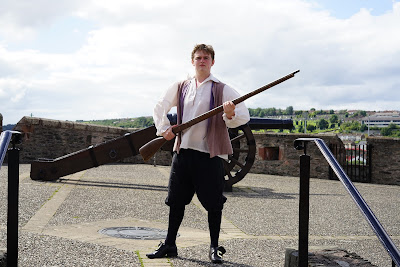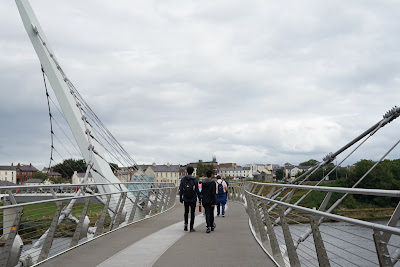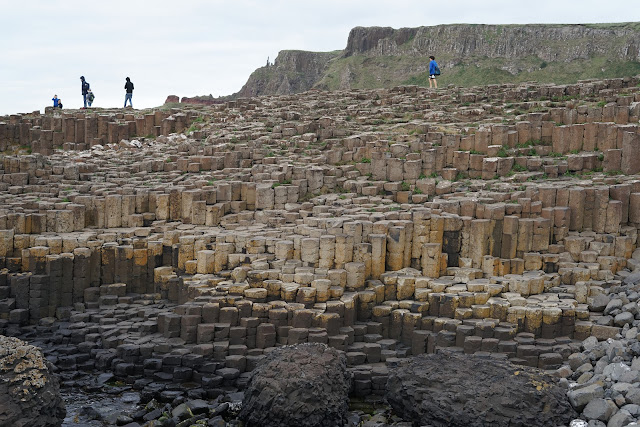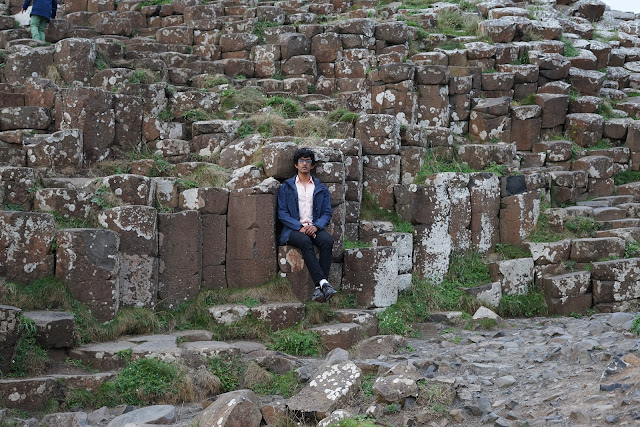Derry and Giant's causaway
After an overnight stay in Sligo, we woke up to a beautiful view from the B&B we rented. This family had dogs, cats and chicken !
The little place we stayed at. It appears to be a remodeled garage with a loft. Spacious with all the facilities. It was quite comfortable.
Off to Derry, back to scenic views from the car.
Entered Northern Ireland (UK) and arrived in Derry. Kilometers changed to miles and euros changed to pounds. Derry is a really interesting, charming city with lot of history and a name that is still not finalised !
We found a bistro and grabbed a quick bite.
You can see some of the famous Bogside murals (more on this later) on the walls of buildings in Derry
The walled city has some 24 cannons still on display
An homage to the fallen soldiers of WW I & II.
The violent times for the most part of the second half of the 20th century define Northern Ireland. Derry is a vibrant city with a rich history of struggles between the Irish and the UK. It's Derry when you approach from Ireland (Nationalist), and Londonderry when you come from UK (Unionist). In many places, the 'London' is scratched out. This city faced lot of sectarian violence, since even though the Catholics (Nationalist) were the majority, it was the protestants (Unionists) who ruled and discriminated against the Catholics (housing, jobs, votes etc). This led to the uprising called Bloody Sunday (Jan 1972) where 14 of the protestors were killed by the British forces, called in to help keep the protest under control. Below are the famous Bogside Murals, that depict this day and its events in a series of 12 murals painted on residential buildings. There are walking tours that cover this story behind each of the murals.
The one below, I found particularly poignant. It's that of a 14 year old school girl who was the first to be shot by the British army on Bloody Sunday.
Many Palestinian flags can be seen here. The people here have a solidarity with the Palestinians as their problems are similar - People are oppressed within their homelands by powerful occupiers.
Some form of peace started to form only after David Cameron, the Prime Minister of UK apologized to the Irish for the violence surrounding Bloody Sunday. The tour guide told us a little story: The wife of one man who was killed in the riots (who was 73 when UK apologized) was asked what she would say to Cameron when he apologized for killing her husband. She replied that she would invite him for a wee cup of tea and biscuits. Apparently, that moved many people and they decided that enough is enough and its time to move on.
A peace bridge was built across the river Foyle.
A lady doing a head-stand on the rocks !
Can't get enough of these amazing geometric patterned rocks !
We got very late by the time we were done. We spent only about 45 minutes here-- could easily have spent 2 hours on these rocks. Ended up having a quick dinner at Dominos Pizza! Then, we checked into our apartment for the night. The car was misbehaving a bit towards the end and there is a red light on the dashboard. We were too tired, so we will need to look into it the next day. Also the Wi-Fi unit had stopped working once we entered Northern Ireland, which was a bit of a bummer.
The little place we stayed at. It appears to be a remodeled garage with a loft. Spacious with all the facilities. It was quite comfortable.
Off to Derry, back to scenic views from the car.
Entered Northern Ireland (UK) and arrived in Derry. Kilometers changed to miles and euros changed to pounds. Derry is a really interesting, charming city with lot of history and a name that is still not finalised !
We found a bistro and grabbed a quick bite.
The burger Neel ordered looked impressive.
We took a walking tour of the city.
Derry is a walled city.
The curbs are painted in the colors of the British flags (Unionist).
You can see some of the famous Bogside murals (more on this later) on the walls of buildings in Derry
 |
Some local kids were performing their traditional dance on the Derry walls.
The walled city has some 24 cannons still on display
Below is the Guildhall-- Derry's city hall. Its a beautiful building and has a nice exhibit of the history of Derry
The violent times for the most part of the second half of the 20th century define Northern Ireland. Derry is a vibrant city with a rich history of struggles between the Irish and the UK. It's Derry when you approach from Ireland (Nationalist), and Londonderry when you come from UK (Unionist). In many places, the 'London' is scratched out. This city faced lot of sectarian violence, since even though the Catholics (Nationalist) were the majority, it was the protestants (Unionists) who ruled and discriminated against the Catholics (housing, jobs, votes etc). This led to the uprising called Bloody Sunday (Jan 1972) where 14 of the protestors were killed by the British forces, called in to help keep the protest under control. Below are the famous Bogside Murals, that depict this day and its events in a series of 12 murals painted on residential buildings. There are walking tours that cover this story behind each of the murals.
The one below, I found particularly poignant. It's that of a 14 year old school girl who was the first to be shot by the British army on Bloody Sunday.
Many Palestinian flags can be seen here. The people here have a solidarity with the Palestinians as their problems are similar - People are oppressed within their homelands by powerful occupiers.
Some form of peace started to form only after David Cameron, the Prime Minister of UK apologized to the Irish for the violence surrounding Bloody Sunday. The tour guide told us a little story: The wife of one man who was killed in the riots (who was 73 when UK apologized) was asked what she would say to Cameron when he apologized for killing her husband. She replied that she would invite him for a wee cup of tea and biscuits. Apparently, that moved many people and they decided that enough is enough and its time to move on.
A peace bridge was built across the river Foyle.
After Derry, we drove to Portrush, a seaside resort town, where we planned to stay the night.
We drove to a main attraction there, the Giant's Causeway - a 5 mile stretch of coastline famous for its bizarre basalt columns that are mostly hexagonal and stick up at various heights ! This is quite a natural wonder. About 37000 columns of rocks rise up from the ground. They are closely packed in an interlocking pattern. Its a half mile hike down from the visitor center.
Very fun to climb !!
Neel sitting in the wishing chair (also formed naturally).
Sitting and watching sunset -- so peaceful. There were not many folks around at this time (8:00 pm)
Geologists believe this formation was caused by volcanic eruptions more than 60 million years ago. Its the nature of the basaltic lava cooling that allows this to happen, this lava is hotter and moves faster than other kinds. As it cools from bottom up and from the center outward, long fractures form columns that at times look exactly hexagonal. The process is called columnar jointing. As the columns settled and erode, they brake up to get the many stair-like steps that dot this landscape.
Similar hexagonal columns are found in a few other places in the world (Scotland, Japan, California, Mexico, Russia, South Korea, Spain etc) but the basalt columns in Ireland is the most famous.
Some of the columns are very tall.
Satto in the wishing chair.
We saw a gorgeous sunset !
We got very late by the time we were done. We spent only about 45 minutes here-- could easily have spent 2 hours on these rocks. Ended up having a quick dinner at Dominos Pizza! Then, we checked into our apartment for the night. The car was misbehaving a bit towards the end and there is a red light on the dashboard. We were too tired, so we will need to look into it the next day. Also the Wi-Fi unit had stopped working once we entered Northern Ireland, which was a bit of a bummer.










































































Comments
Post a Comment